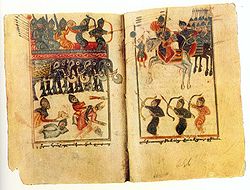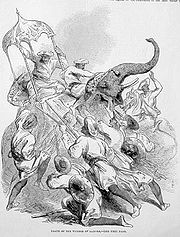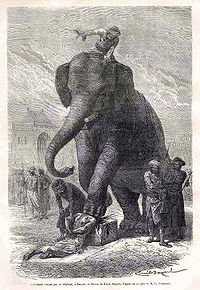
Persian war elephants
Encyclopedia

War elephant
A war elephant was an elephant trained and guided by humans for combat. Their main use was to charge the enemy, trampling them and breaking their ranks. A division of war elephants is known as elephantry....
s at the Battle of Gaugamela
Battle of Gaugamela
The Battle of Gaugamela took place in 331 BC between Alexander the Great and Darius III of Persia. The battle, which is also called the Battle of Arbela, resulted in a massive victory for the ancient Macedonians and led to the fall of the Achaemenid Empire.-Location:Darius chose a flat, open plain...
in 331 BC
331 BC
Year 331 BC was a year of the pre-Julian Roman calendar. At the time, it was known as the Year of the Consulship of Potitus and Marcellus...
. The battle raged between king Alexander the Great of Macedon
Macedon
Macedonia or Macedon was an ancient kingdom, centered in the northeastern part of the Greek peninsula, bordered by Epirus to the west, Paeonia to the north, the region of Thrace to the east and Thessaly to the south....
and king Darius III of Persia. The Persians had 15 Indian-trained war elephants, which were placed at the centre of the Persian line, and they made such an impression on the Macedonian troops that Alexander felt the need to sacrifice to the God of Fear the night before the battle. Despite this the Persians lost the battle, relinquishing the Achaemenid Persian empire to Alexander. Elephants were later used by the Sassanids under a special chief, known as the Zend−hapet, or "Commander of the Indians," as they were from India
India
India , officially the Republic of India , is a country in South Asia. It is the seventh-largest country by geographical area, the second-most populous country with over 1.2 billion people, and the most populous democracy in the world...
.
Under the Achaemenids
The Persians are known to have used fifteen war elephants at GaugamelaBattle of Gaugamela
The Battle of Gaugamela took place in 331 BC between Alexander the Great and Darius III of Persia. The battle, which is also called the Battle of Arbela, resulted in a massive victory for the ancient Macedonians and led to the fall of the Achaemenid Empire.-Location:Darius chose a flat, open plain...
, but some people claim that they had been used previously in the Greek campaign of king Xerxes I of Persia, and even further back at the time of Darius the Great
Darius I of Persia
Darius I , also known as Darius the Great, was the third king of kings of the Achaemenid Empire...
at the Indus, the Danube and against the Scythians in 512BC. Neither Xenophon
Xenophon
Xenophon , son of Gryllus, of the deme Erchia of Athens, also known as Xenophon of Athens, was a Greek historian, soldier, mercenary, philosopher and a contemporary and admirer of Socrates...
nor Herodotus
Herodotus
Herodotus was an ancient Greek historian who was born in Halicarnassus, Caria and lived in the 5th century BC . He has been called the "Father of History", and was the first historian known to collect his materials systematically, test their accuracy to a certain extent and arrange them in a...
mention war elephants in their accounts of these earlier campaigns.
Julian's campaign
.png)
Julian the Apostate
Julian "the Apostate" , commonly known as Julian, or also Julian the Philosopher, was Roman Emperor from 361 to 363 and a noted philosopher and Greek writer....
marshaled an army of 90,000 Roman
Roman Empire
The Roman Empire was the post-Republican period of the ancient Roman civilization, characterised by an autocratic form of government and large territorial holdings in Europe and around the Mediterranean....
troops to invade the Sassanid Territory with the intention of ravaging the Imperial capital of Ctesiphon
Ctesiphon
Ctesiphon, the imperial capital of the Parthian Arsacids and of the Persian Sassanids, was one of the great cities of ancient Mesopotamia.The ruins of the city are located on the east bank of the Tigris, across the river from the Hellenistic city of Seleucia...
. The Persian Shah
Shah
Shāh is the title of the ruler of certain Southwest Asian and Central Asian countries, especially Persia , and derives from the Persian word shah, meaning "king".-History:...
, Shapur II
Shapur II
Shapur II the Great was the ninth King of the Persian Sassanid Empire from 309 to 379 and son of Hormizd II. During his long reign, the Sassanid Empire saw its first golden era since the reign of Shapur I...
, was astute enough a tactician to realize his soldiers' only chance of challenging the well-trained and better-equipped Romans was a clandestine attack. While the Romans were encamped outside the walls of the capital, the Persians launched a surprise assault onto the unsuspecting army leading with a force of heavy infantry
Infantry
Infantrymen are soldiers who are specifically trained for the role of fighting on foot to engage the enemy face to face and have historically borne the brunt of the casualties of combat in wars. As the oldest branch of combat arms, they are the backbone of armies...
, cataphracts and elephants. Caught unaware, the Roman soldiers fought valiantly but eventually ended up losing the battle.
During the melee, Julian foolishly charged into the conflict without his armour and was injured by an arrow. Although initially surviving, he later succumbed to the injury and died.
Belisarius
Belisarius
Flavius Belisarius was a general of the Byzantine Empire. He was instrumental to Emperor Justinian's ambitious project of reconquering much of the Mediterranean territory of the former Western Roman Empire, which had been lost less than a century previously....
remarks on Sassanid troops:
Armenian wars
The most famous was the Battle of Avarayr in 451 CE, where ArmenianArmenians
Armenian people or Armenians are a nation and ethnic group native to the Armenian Highland.The largest concentration is in Armenia having a nearly-homogeneous population with 97.9% or 3,145,354 being ethnic Armenian....
rebels led by Vartan Mamikonian led an army of 66,000 men to gain independence from the Sassanids under Yazdegerd II
Yazdegerd II
Yazdegerd II was the fifteenth Sassanid King of Persia. He was the son of Bahram V and reigned from 438 to 457....
, who opposed them with forces including war elephants.
Despite their victory over the rebels and the death of their leadership (including Vartan Mamikonian), Yazdegerd was generous and gave the Armenians their religious freedom.
Persians fighting elephants
In 1739, Nader ShahNader Shah
Nāder Shāh Afshār ruled as Shah of Iran and was the founder of the Afsharid dynasty. Because of his military genius, some historians have described him as the Napoleon of Persia or the Second Alexander...
of Persia invaded India and led an army to their capital , Delhi
Delhi
Delhi , officially National Capital Territory of Delhi , is the largest metropolis by area and the second-largest by population in India, next to Mumbai. It is the eighth largest metropolis in the world by population with 16,753,265 inhabitants in the Territory at the 2011 Census...
but on the way he was halted by the Mughul India
India
India , officially the Republic of India , is a country in South Asia. It is the seventh-largest country by geographical area, the second-most populous country with over 1.2 billion people, and the most populous democracy in the world...
n ruler Muhammad Shah and his huge army, it greatly outnumbered the Persian army. The Indians also had war elephants with them, they had blades on their tusks which they were taught to use against the enemy. Nader shah sent his pots of oil to the front lines where the goats horns were ordered to be set on fire. The goats charged at the elephants who panicked and turned around killing thousands of Indian troops just like at the battle of al-Qādisiyyah
Battle of al-Qadisiyyah
The Battle of al-Qādisiyyah was fought in 636; it was the decisive engagement between the Arab muslim army and the Sassanid Persian army during the first period of Muslim expansion. It resulted in the Islamic conquest of Persia, and was key to the conquest of Iraq...
, they were proved to be "double edged weapons".
Origin and training

Mercenary
A mercenary, is a person who takes part in an armed conflict based on the promise of material compensation rather than having a direct interest in, or a legal obligation to, the conflict itself. A non-conscript professional member of a regular army is not considered to be a mercenary although he...
troops as well as their riders. They were from the Indian territories under Persian rule. Some historians say that some were actually from Iran itself. They were called Syrian Elephant
Syrian Elephant
The Syrian elephant is a proposed name for the westernmost population of the Asian Elephant which became extinct in ancient times...
. However, this is highly unlikely as most historians and sources do not say this is correct.
All the times Persians used war elephants they were trained by their rider called a mahout
Mahout
A mahout is a person who drives an elephant. The word mahout comes from the Hindi words mahaut and mahavat. Usually, a mahout starts as a boy in the 'family business' when he is assigned an elephant early in its life and they would be attached to each other throughout the elephant's life.The most...
, who would also ride the elephant into battle as well. The mahout
Mahout
A mahout is a person who drives an elephant. The word mahout comes from the Hindi words mahaut and mahavat. Usually, a mahout starts as a boy in the 'family business' when he is assigned an elephant early in its life and they would be attached to each other throughout the elephant's life.The most...
would be from India
India
India , officially the Republic of India , is a country in South Asia. It is the seventh-largest country by geographical area, the second-most populous country with over 1.2 billion people, and the most populous democracy in the world...
n origin and so were the archers. Training elephants was a difficult job. They would be hard to maintain because they ate so much food and water. Also they were hard to march with as huge paths needed to be cut in order for elephants to march through. Another reason was that they were expensive to hire and sometimes would panic if they were under heavy fire from spears and arrows. Thousands of them lived in the elephant farms. Many were kept in the shah's menagerie
Menagerie
A menagerie is/was a form of keeping common and exotic animals in captivity that preceded the modern zoological garden. The term was first used in seventeenth century France in reference to the management of household or domestic stock. Later, it came to be used primarily in reference to...
the most famous of which was Khosrau II
Khosrau II
250px|thumb|Khosrau II 250px|thumb|Khosrau II 250px|thumb|Khosrau II (Khosrow II, Chosroes II, or Xosrov II in classical sources, sometimes called Parvez, "the Ever Victorious" – (in Persian: خسرو پرویز), was the twenty-second Sassanid King of Persia, reigning from 590 to 628...
where he kept a "thousand white elephants
White elephant (pachyderm)
A white elephant is a rare kind of elephant, but not a distinct species. Although often depicted as snow white, their skin is normally a soft reddish-brown, turning a light pink when wet. They have fair eyelashes and toenails....
."
Weapons
Persian elephants were from Indian origin and were probably armed with Indian styled weapons. The men(excluding the driver) sat in a large tower from which troops would fight. The elephant itself would normally be armed with thin plate armour (the Sassanids used chain mail as well as thin plate armour)and would bear a large crenelated wooden howdahHowdah
A howdah, or houdah, also known as hathi howdah, is a carriage which is positioned on the back of an elephant, or occasionally some other animal, used most often in the past to carry wealthy people or for use in hunting or warfare...
on its back. The troops would be armed with bow and arrows and javelin
Javelin
A Javelin is a light spear intended for throwing. It is commonly known from the modern athletic discipline, the Javelin throw.Javelin may also refer to:-Aviation:* ATG Javelin, an American-Israeli civil jet aircraft, under development...
. The sworn enemy of the Sassanids, the Eastern Roman empire, were terrified by the huge beasts, making them very effective in battle. When they were used at the Battle of al-Qādisiyyah
Battle of al-Qadisiyyah
The Battle of al-Qādisiyyah was fought in 636; it was the decisive engagement between the Arab muslim army and the Sassanid Persian army during the first period of Muslim expansion. It resulted in the Islamic conquest of Persia, and was key to the conquest of Iraq...
, they came to be known as "double edged weapons". King ( shah
Shah
Shāh is the title of the ruler of certain Southwest Asian and Central Asian countries, especially Persia , and derives from the Persian word shah, meaning "king".-History:...
) Yazdgerd III
Yazdgerd III
Yazdegerd III or Yazdgerd III was the twenty-ninth and last king of the Sassanid dynasty of Iran and a grandson of Khosrau II . His father was Shahryar, whose mother was Miriam, the daughter of the Byzantine Emperor Maurice...
attempted to use war elephants to fight off Arab invaders, however his elephants got sand in their eyes and panicked. They turned around and ran amok, killing their own troops.
Crushing by elephant

Elephant
Elephants are large land mammals in two extant genera of the family Elephantidae: Elephas and Loxodonta, with the third genus Mammuthus extinct...
's feet")
Those people that were traitors to the army, enemies of the empire and criminals were crushed by the elephants this way and executed in the age of Sassanids they also used this method of execution for training for battle.
In popular culture
- ShatranjShatranjShatranj is an old form of chess, which came to the Western world from India. Modern chess has gradually developed from this game.-Etymology and origins:...
(Persian chess) - which Modern chess has gradually developed from it, same as Indian chess includes the war elephant with the name (fil),meaning elephant in Persian as the bishopBishop (chess)A bishop is a piece in the board game of chess. Each player begins the game with two bishops. One starts between the king's knight and the king, the other between the queen's knight and the queen...
.
See also
- War elephantWar elephantA war elephant was an elephant trained and guided by humans for combat. Their main use was to charge the enemy, trampling them and breaking their ranks. A division of war elephants is known as elephantry....
- Crushing by elephantCrushing by elephantExecution by elephant was a common method of capital punishment in South and Southeast Asia, and particularly in India. Asian Elephants were used to crush, dismember, or torture captives in public executions. The animals were trained and versatile, both able to kill victims immediately or to...
- Sassanid armySassanid armyThe birth of the Sassanid army dates back to the rise of Ardashir I , the founder of the Sassanid dynasty, to the throne. Ardashir aimed at the revival of the Persian Empire, and to further this aim, he reformed the military by forming a standing army which was under his personal command and whose...
- History of elephants in EuropeHistory of elephants in EuropeThe history of elephants in Europe dates back to the ice ages, when mammoths roamed the northern parts of the Earth, from Europe to North America There was also the dwarf elephant of Cyprus , Sicily-Malta and mainland The history of elephants in Europe dates back to the ice ages, when mammoths...
- List of historical elephants
- Military animals
- Cavalry tacticsCavalry tacticsFor much of history , humans have used some form of cavalry for war. Cavalry tactics have evolved over time...
External links
- http://www.iranchamber.com/history/parthians/parthians.php
- http://www.artarena.force9.co.uk/sass2.htm

